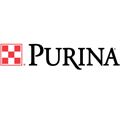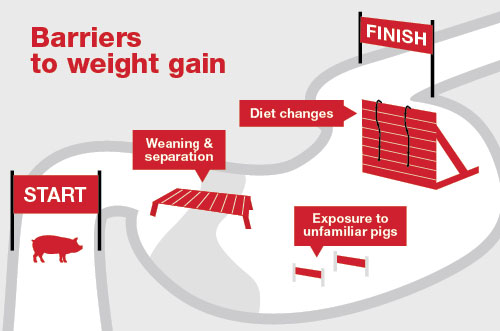 How do you get the most pounds from your pigs at market? Are you finishing pigs at higher weights? Or, trying to cut down on days to market? There’s no right or wrong answer. But, one strategy can help no matter the game plan – feeding pigs the right nutrition at the right time, from wean to finish.
How do you get the most pounds from your pigs at market? Are you finishing pigs at higher weights? Or, trying to cut down on days to market? There’s no right or wrong answer. But, one strategy can help no matter the game plan – feeding pigs the right nutrition at the right time, from wean to finish.
“Optimal weight gain starts by providing the correct nutrients that encourage consistent intake,” says Stacie Crowder, lead swine nutritionist, Purina Animal Nutrition. “As pigs transition diets, they experience metabolic changes and other stressors that can cause a drop in feed intake. The right nutrition, combined with the proper care at each transition, can help pigs power through performance barriers.”

Here are three tips to avoid feed intake pitfalls and keep pigs performing:
1. Start with strong weaned pig feed intake
“The first hurdle is the transition from sow’s milk to dry feed,” Crowder says. “Until now, the piglet has only known the sow as food source and only been familiar with the taste and smell of the farrowing pen. Nursery feed ingredients need to include the right taste and smell profiles to set off chemical reactions and drive the pig to start eating.”
Average feed intake in the first 3-4 days post-weaning is too low to meet the pig’s energy requirements for maintenance and growth.[1] You can close the energy gap with complex, highly digestible feed ingredients. These ingredients trigger receptors along the pig’s digestive tract that drive metabolic function. This process helps pigs get the most out of the feed they eat and drives consistent feed intake.
2. Stay the course when diets change
“Any diet change can disrupt feed intake,” Crowder says. “The transition from complex nursery diets to less complex grind-and-mix grower diets is no exception and poses unique challenges. Less complex diets provide only moderate support to the gut. This transition is important to manage because the gut contains about 70% of the pig’s immune system. As gut function declines, the potential risk increases for disease and performance loss.”
To help pigs transition from nursery diets, use feed technologies that provide support for gut health. For example, medium-chain fatty acids help maintain the integrity of the gut lining, which acts as a barrier to pathogens. A healthy, well-developed gut also has optimal surface area for nutrient absorption so pigs can use more nutrients.
3. Focus on details when pigs near the finish line
“Pigs in late finishing are less efficient,” says Crowder. “In finishing, pigs transition from mostly lean muscle deposition to a mixed lean and fat deposition phase, which is a less efficient metabolic process. Environmental or management aspects such as feeder competition, floor space limitations and feed outage events can exacerbate the decline in efficiency.”
Proper floor space management can help maximize weight gain during the grow/finish phases. Changes in stocking density correlate to pig performance. The 250-pound pig can experience a 5% decline in average daily gain when floor space drops from 8.5 square feet per pig to 7.2 square feet per pig.[2] Plan your space accordingly.
Feeder management also becomes a challenge when pigs reach market weights. Pigs heavier than 285 pounds might eat an additional pound per day compared to lighter pigs. In a 2,400-head barn, that could add up to an additional ton of feed per day.
“Checking feeders at least once per day helps to avoid feed outages and is a best practice in any production phase,” says Crowder. “During late finishing, keeping a close eye on your feed inventory can make the difference between continued gains or performance loss.”
Keep the feed flowing
Many factors impact feed intake including stress, health challenges and the feed itself. But, one strategy can help you maintain performance through to market.

“You will be more likely to achieve weight goals by keeping pigs eating consistently from start to finish,” Crowder says. “Encouraging early feed intake, supporting gut health through diet transitions, and avoiding feed outages will keep your pigs on pace through finishing.”
Find solutions to reach your pig performance goals at progresstoprofit.com
[1] Le Dividich, J. and Seve, B. 2001. Energy requirements of the young pig. In: Varley, M.A. and Wiseman, J. (eds). The weaner pig: nutrition and management. CAB International, United Kingdom, pp. 17-44.
[2] Brumm, M., “Space Allocation Decisions for Nursery and Grow-Finish Facilities”, Pork Information Gateway. 2006
August 26, 2019 - Purina Animal Nutrition LLC




